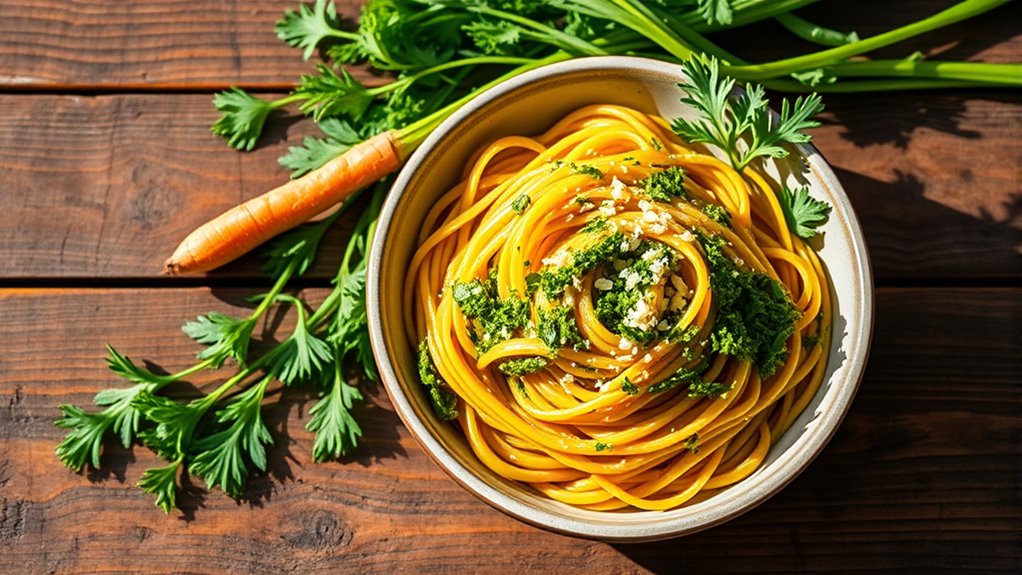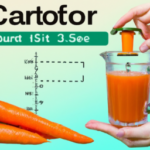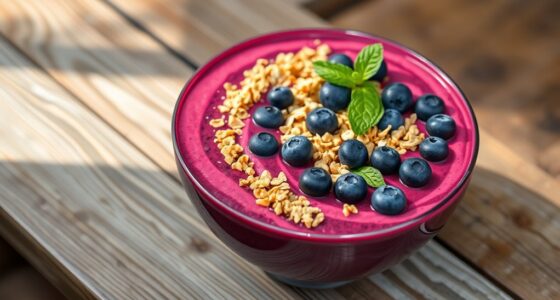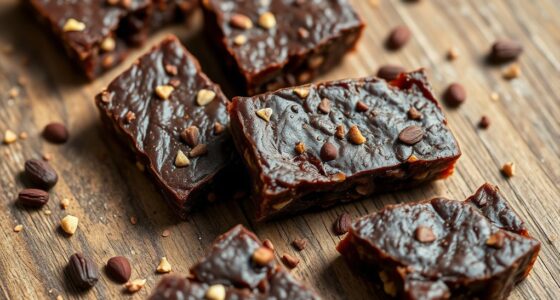Transform your leftovers into a delicious, sustainable meal by making carrot top pesto and tossing it with pasta. Use all parts of the carrot, especially the greens, to reduce waste and add fresh, herbaceous flavor. Blending carrot tops creates a bright pesto that elevates your dish while respecting nature and supporting eco-friendly practices. Curious how to do this step-by-step? Keep exploring ways to make your meals more resourceful and tasty.
Key Takeaways
- Use carrot tops to make a vibrant, herbaceous pesto that reduces food waste and maximizes ingredient usage.
- Blend carrot greens with garlic, nuts, olive oil, and cheese to create a flavorful, nutrient-rich sauce.
- Toss the pesto with cooked pasta for a sustainable, delicious meal that highlights root-to-stem cooking principles.
- Incorporate organic or local carrots to support eco-friendly farming and promote responsible resource use.
- Embrace this sustainable approach to enjoy a tasty, environmentally conscious dish that honors ingredients and reduces waste.
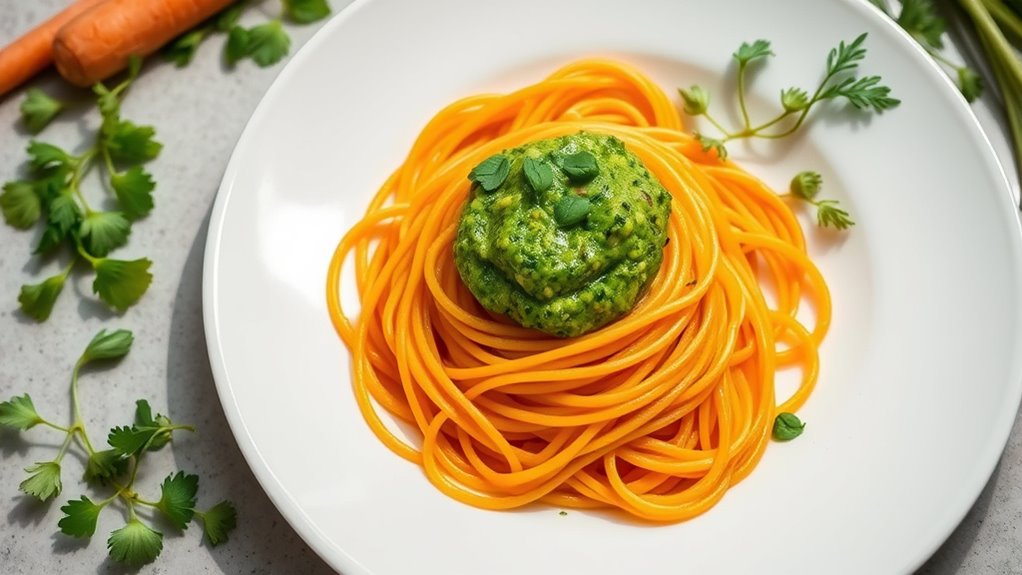
If you’re looking to reduce waste and boost flavor in your kitchen, root-to-stem cooking offers the perfect solution. By using every part of the carrot, including the vibrant green tops, you’re embracing a more sustainable approach to cooking that benefits both your palate and the environment. This practice aligns with sustainable farming principles, which prioritize resource efficiency and minimize waste. Instead of tossing the carrot tops into the compost or trash, you harness their flavor and nutritional potential, turning what’s often discarded into a delicious, versatile ingredient. This shift not only supports eco-conscious choices but also sparks culinary innovation, encouraging you to experiment with new flavors and techniques.
Using carrot tops in pesto is a smart way to elevate your dishes with fresh, herbaceous notes. The tops are packed with bright, grassy flavors similar to parsley or basil, making them an excellent base for a vibrant pesto. Blending these greens with garlic, nuts, olive oil, and a touch of cheese creates a condiment that’s both fresh and deeply flavorful. The process is straightforward, but the results are impressive—adding a unique twist to pasta dishes that brings out the best in simple ingredients. You get to enjoy a homemade, nutrient-dense pesto that’s as sustainable as it is tasty, reducing food waste while expanding your culinary repertoire.
Use carrot tops in pesto for a fresh, herbaceous twist that reduces waste and boosts flavor.
Once your pesto is ready, tossing it with cooked pasta transforms a humble meal into something special. The pasta absorbs the flavors beautifully, creating a dish that’s rich in taste but light on environmental impact. By choosing organic or locally sourced carrots and greens, you further support sustainable farming practices that prioritize soil health and biodiversity. This approach encourages you to see food as a resource to be maximized, rather than squandered, fostering a more mindful relationship with what you eat. It’s a small change that makes a significant difference, demonstrating how sustainable farming and culinary innovation can come together effortlessly on your plate.
Incorporating root-to-stem cooking into your routine not only enhances your meals but also champions responsible consumption. It’s an act of respect for the ingredients and the farmers who grow them, emphasizing the importance of reducing waste at every stage. As you experiment with carrot top pesto and pasta, you become part of a broader movement that values creativity, sustainability, and the thoughtful use of resources. It’s a simple yet impactful way to enjoy delicious food while supporting environmentally friendly practices—proof that good taste and good conscience can go hand in hand.
Frequently Asked Questions
Can Carrot Top Pesto Be Stored Long-Term?
Yes, you can store carrot top pesto long-term if you follow proper pesto preservation and storage methods. Transfer it to an airtight container, smooth the surface, and add a thin layer of olive oil to prevent oxidation. Store it in the freezer for up to 3-6 months, or in the refrigerator for about a week. Proper storage methods guarantee your pesto stays fresh and flavorful for future use.
Are There Vegan Alternatives to Traditional Pesto Ingredients?
Surprisingly, yes, vegan alternatives to traditional pesto ingredients exist and are worth trying. Instead of cheese, you can use vegan cheese or nut substitutes like cashews or walnuts for creaminess. These options mimic the texture and flavor, proving that you don’t need dairy to enjoy a delicious pesto. So, go ahead and experiment—your taste buds will thank you for this plant-based twist!
How Do I Prevent Pasta From Sticking Together?
To prevent pasta from sticking together, use proper pasta cooking techniques. Start by boiling plenty of water and adding a generous pinch of salt. Stir the pasta frequently during the first few minutes to prevent clumping. Once cooked, drain immediately and toss with a little oil or sauce to keep the noodles separate. Avoid overcooking, and always stir occasionally to guarantee even cooking and preventing sticking.
What Are Some Creative Ways to Use Carrot Top Pesto?
You can get creative with carrot top pesto by spreading it on toast or mixing it into grain bowls for added flavor. Try blending carrot peel uses by incorporating them into the pesto for extra texture. Experiment with carrot top pesto variations, like adding nuts or cheese, to enhance its taste. Use it as a dip, spread, or topping for grilled vegetables or meats, making your dishes vibrant and eco-friendly.
Is This Recipe Suitable for People With Nut Allergies?
If you or someone you know has nut allergy concerns, this recipe might not be suitable as is, since traditional pestos often include nuts. But don’t worry—by using ingredient substitutions like seeds (sunflower or pumpkin seeds) or skipping nuts altogether, you can create a nut-free version. Just be sure to check all ingredients for cross-contamination to keep everyone safe and enjoy your meal worry-free.
Conclusion
By using carrot tops in your pesto, you not only cut down on waste but also create a fresh, flavorful dish. Imagine hosting a dinner where guests rave about your unique, sustainable meal—like Sarah, who turned leftover carrot greens into a vibrant pesto that wowed everyone. This simple swap proves that small changes can make a big difference, turning everyday ingredients into something delicious and eco-friendly. So next time, embrace the whole carrot and enjoy the tasty rewards.
Ilana has been a vegan for over 10 years. She originally made the switch for health reasons, but soon found herself becoming more and more passionate about the ethical and environmental implications of a vegan lifestyle. Ilana is the author of The Graceful Kitchen, a blog all about veganism. She loves to cook up delicious and nutritious vegan meals, and share her recipes with others who are interested in leading a cruelty-free life. Ilana is also a strong advocate for using whole foods as the foundation of a healthy diet, and believes that going vegan is one of the best ways to achieve this.
